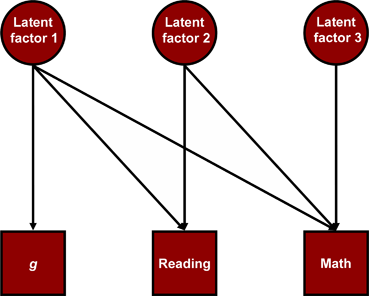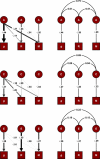Generalist genes and the Internet generation: etiology of learning abilities by web testing at age 10
- PMID: 17983460
- PMCID: PMC2408664
- DOI: 10.1111/j.1601-183X.2007.00370.x
Generalist genes and the Internet generation: etiology of learning abilities by web testing at age 10
Abstract
A key translational issue for neuroscience is to understand how genes affect individual differences in brain function. Although it is reasonable to suppose that genetic effects on specific learning abilities, such as reading and mathematics, as well as general cognitive ability (g), will overlap very little, the counterintuitive finding emerging from multivariate genetic studies is that the same genes affect these diverse learning abilities: a Generalist Genes hypothesis. To conclusively test this hypothesis, we exploited the widespread access to inexpensive and fast Internet connections in the UK to assess 2541 pairs of 10-year-old twins for reading, mathematics and g, using a web-based test battery. Heritabilities were 0.38 for reading, 0.49 for mathematics and 0.44 for g. Multivariate genetic analysis showed substantial genetic correlations between learning abilities: 0.57 between reading and mathematics, 0.61 between reading and g, and 0.75 between mathematics and g, providing strong support for the Generalist Genes hypothesis. If genetic effects on cognition are so general, the effects of these genes on the brain are also likely to be general. In this way, generalist genes may prove invaluable in integrating top-down and bottom-up approaches to the systems biology of the brain.
Figures


Similar articles
-
Generalist genes and learning disabilities: a multivariate genetic analysis of low performance in reading, mathematics, language and general cognitive ability in a sample of 8000 12-year-old twins.J Child Psychol Psychiatry. 2009 Oct;50(10):1318-25. doi: 10.1111/j.1469-7610.2009.02114.x. Epub 2009 Jul 1. J Child Psychol Psychiatry. 2009. PMID: 19573035 Free PMC article.
-
Learning abilities and disabilities: generalist genes in early adolescence.Cogn Neuropsychiatry. 2009;14(4-5):312-31. doi: 10.1080/13546800902797106. Cogn Neuropsychiatry. 2009. PMID: 19634033 Free PMC article.
-
Genome-wide quantitative trait locus association scan of general cognitive ability using pooled DNA and 500K single nucleotide polymorphism microarrays.Genes Brain Behav. 2008 Jun;7(4):435-46. doi: 10.1111/j.1601-183X.2007.00368.x. Epub 2008 Jan 22. Genes Brain Behav. 2008. PMID: 18067574 Free PMC article.
-
Generalist genes and cognitive neuroscience.Curr Opin Neurobiol. 2006 Apr;16(2):145-51. doi: 10.1016/j.conb.2006.03.004. Epub 2006 Mar 24. Curr Opin Neurobiol. 2006. PMID: 16563732 Review.
-
Quantitative genetics in the era of molecular genetics: learning abilities and disabilities as an example.J Am Acad Child Adolesc Psychiatry. 2010 Aug;49(8):783-93. doi: 10.1016/j.jaac.2010.01.026. Epub 2010 May 5. J Am Acad Child Adolesc Psychiatry. 2010. PMID: 20643312 Free PMC article. Review.
Cited by
-
Generalist genes and high cognitive abilities.Behav Genet. 2009 Jul;39(4):437-45. doi: 10.1007/s10519-009-9271-2. Epub 2009 Apr 18. Behav Genet. 2009. PMID: 19377870 Free PMC article.
-
Genetic foundations of human intelligence.Hum Genet. 2009 Jul;126(1):215-32. doi: 10.1007/s00439-009-0655-4. Epub 2009 Mar 18. Hum Genet. 2009. PMID: 19294424 Review.
-
Twins Early Development Study (TEDS): a genetically sensitive investigation of cognitive and behavioral development from childhood to young adulthood.Twin Res Hum Genet. 2013 Feb;16(1):117-25. doi: 10.1017/thg.2012.91. Epub 2012 Oct 30. Twin Res Hum Genet. 2013. PMID: 23110994 Free PMC article.
-
The etiology of diverse receptive language skills at 12 years.J Speech Lang Hear Res. 2010 Aug;53(4):982-92. doi: 10.1044/1092-4388(2009/09-0108). Epub 2010 Jul 6. J Speech Lang Hear Res. 2010. PMID: 20605943 Free PMC article.
-
Generalist genes and learning disabilities: a multivariate genetic analysis of low performance in reading, mathematics, language and general cognitive ability in a sample of 8000 12-year-old twins.J Child Psychol Psychiatry. 2009 Oct;50(10):1318-25. doi: 10.1111/j.1469-7610.2009.02114.x. Epub 2009 Jul 1. J Child Psychol Psychiatry. 2009. PMID: 19573035 Free PMC article.
References
-
- Armstrong JD, Pocklington AJ, Cumiskey MA, Grant SG. Reconstructing protein complexes: from proteomics to systems biology. Proteomics. 2006;6:4724–4731. - PubMed
-
- Birnbaum MH. Human research and data collection via the internet. Annu Rev Psychol. 2004;55:803–832. - PubMed
-
- Boomsma DI. Current status and future prospects in twin studies of the development of cognitive abilities: infancy to old age. In: Bouchard TJ Jr, Propping P, editors. Twins as a Tool of Behavioral Genetics. Chichester: Wiley; 1993. pp. 67–82.
-
- Boomsma D, Busjahn A, Peltonen L. Classical twin studies and beyond. Nat Rev Genet. 2002;3:872–882. - PubMed
-
- Butcher LM, Meaburn E, Knight J, Sham P, Schalkwyk LC, Craig IW, Plomin R. SNPs, microarrays, and pooled DNA: identification of four loci associated with mild mental impairment in a sample of 6000 children. Hum Mol Genet. 2005;14:1315–1325. - PubMed
Publication types
MeSH terms
Grants and funding
LinkOut - more resources
Full Text Sources

